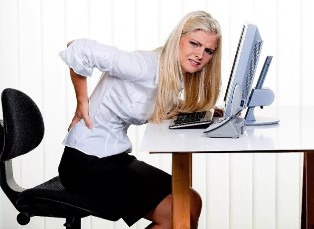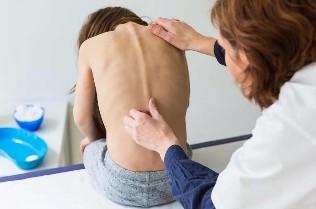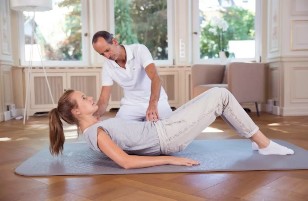The osteochondrosis – degenerative of the defeat of the cartilage of the joints, and subjects below them, the bones of the tissues. The disease affects all the fetters of the locomotor apparatus. In the war of medicine osteochondrosis as a set of calcifications of the processes in the intervertebral discs, the small joints of the spine and vertebrae.

What is osteochondrosis?
The osteochondrosis of the spine is a strap to the neck, chest and back. The type of disease is defined by the localization-modified tissues. On the basis of the pathology is the violation of the trophic of the intervertebral disks and vertebrae. Leads to a change of the normal structure of the cartilage. Due to the dystrophy cartilage of the unit, loses its elasticity, it changes the consistency and form. Reduce the gaps between the vertebrae, and surprised with the segment of the spine loses stability.
Reduction of the distance between the vertebrae is accompanied by tension in the muscles of the back, compression of the nerve roots which leave the spinal cord. This explains the appearance of pain, and focal neurologic to osteochondrosis.
The dystrophy of the discs leads to a weakening of its outer fibrous rings. Therefore, in patients with osteochondrosis often arise protrusion (bulging part of a disc) and spinal hernia (cantilever pulpous nucleus of the disc in the spinal canal). In the future, the pathology is applied to the small joints of the spine, intervertebral ligaments:
- occur bony expansion of the vertebrae;
- the sick, hard to bend, stretch;
- you lose the flexibility of the spine;
- appear vertebral subluxations;
- they are bent out of the affected area of the spine (kyphosis, scoliosis).
Degenerative changes in the cartilage and the bone are the result of normal aging. For various reasons, the development of the pathology is can be accelerated. 70% of patients with osteochondrosis — people over the age of 45 years. The early onset of the pathology is due to the bad to the physical education of children, the overweight in adolescents.
Young people much time passes by computer and tv, avoiding the games, the rides, street sports and not know what is osteochondrosis and how dangerous. Long stay in a sitting position helps to:
- the violation of the position;
- the weakening of the muscles of the back;
- the development of the problems of the column.

The causes of degenerative disc disease
The cause of the disease are divided into 3 groups. The first is associated with an increase of the load on the spine:
- the excess of weight;
- heavy work of a physical (especially the elevations of the load);
- professions that require long periods of time or from a seat;
- the use of uncomfortable shoes, high heels, bags only on one shoulder;
- a bad posture;
- underdeveloped muscular frame due to the sedentary lifestyle;
- congenital and acquired deformation of the spine;
- flat feet.
The second group classified the internal causes:
- the inheritance;
- the changes of age;
- types of infringement;
- the intoxication of the organism;
- nervous tension, the stress;
- heavy somatic disease;
- hormonal changes (for example, during pregnancy, the change of life);
- the autoimmune disease of the connective tissue.
The third group is formed by external causes:
- injuries of the spinal column;
- the lack of vitamins and minerals (especially vitamins D, A, b group, calcium and phosphorus);
- bad habits;
- the dream of uncomfortable the mattress and the pillow.
Professional sport becomes the cause of premature aging of the intervertebral discs every 20 of the athlete. The process of degeneration is accelerated following a suspension of the workouts.
The symptoms of degenerative disc disease
The osteochondrosis is a chronic disease, which happens with the alternation of periods of exacerbation and remission. The development of the symptoms of acute contribute to:
- the excess physical load;
- the exhaustion;
- the supercooling;
- of the injury;
- that move the body and the effect of the vibration.

The clinical picture when the exacerbations depends on the location of the dead of the cartilage, and the presence of complications.
- For degenerative disc disease, cervical characterized by pain in the neck, the hands, stiffness, numbness of fingers, pain of the head. If you compress during vertebral artery, the person's condition gets worse: it appears the throbbing headache, severe dizziness, reduced hearing, they produced "the spotlight before the eyes", are possible fainting.
- The signs of the degenerative disc disease of breast-feeding, and of the division: concerned with acute back pain, the feeling of "stake in the chest, pain in the heart and the internal organs, difficulty breathing (it is hard to breathe the full breast due to muscle stiffness and pain).
- When the lumbar spine osteochondrosis occurs pain in the low back, sacrum and legs, the increase in the time to walk away. Happen back pain in the lower back the effort of a physical, numbness of the lower extremities. Appear dysfunction of the organs genito-urinary (pain, violation of urinary functions, problems of impotence in men, failure in the functioning of the ovaries in women). In the period of remission the patient feels a slight pain, which only occurs under the influence of provoking factors (low, forced by the awkward posture and other things).
The osteochondrosis and tir
The pathology is in the intervertebral joints, often leading to jamming the nerve roots, blood vessels that nourish the brain, to the irritation of vegetative nodes, responsible for the functioning of the internal organs. These factors are the cause of violations cardiovascular and the nervous system. 8 out of 10 patients of the osteochondrosis syndrome develops vascular dystonia (irr), the symptoms:
- sudden changes of the blood pressure;
- headaches;
- nausea and vomiting;
- sleep disorders;
- shortness of breath;
- chills or hot flashes;
- the total of the decrease of the strength.
In severe cases, may result in loss of consciousness.
In 95% of cases is the relationship between the welfare of the sick and conditions meteorolgicas.
Describes the symptoms of the accompany not only the osteochondrosis. Patients with clinical signs similar to a painting need in the survey for the exclusion of somatic pathologies and endocrine.
Diagnosis of degenerative disc disease

The patient should know the medical cure to the osteochondrosis, to go to meet the specialist. Problems of the spinal column is dedicated to a neurologist, should be consulted to pains in the back, the neck, the lower part of the back. The survey of patients with suspected osteochondrosis happens in stages and may take 1 to 7 days:
- survey;
- the external inspection of the spine in different body positions (lying, sitting, standing);
- palpation of the vertebral column, located around the soft tissue;
- the definition of the amplitude of the movements in the different departments of the spinal column;
- instruments of the research: the computed tomography scan, magnetic resonance imaging mri, x-ray.
The difficult diagnosis performed are specific tests of the blood vessels and peripheral nerves.
As to treat osteochondrosis?
The treatment of the osteochondrosis of the spine long, and requires an integrated approach. In the therapy applied medicamentous and physiotherapeutic methods — adjusts the individual approach to each patient. Selection of the scheme of treatment depends on:
- the severity of the disease is;
- the state of the patient;
- the presence of complications of the disease.
Fundamental to the effective treatment for the degenerative disc disease – a step-by-step. The main goal of therapy at the time of aggravation of the disease — elimination of pain. The patient is recommended to rest, the use of the corss and the necks, to the unloading of the spine. Is applied to the interior and exterior of a treatment with medications, is carried out physiotherapy. In the next phase, they are activities that warn new of the sharpening:
- therapeutic exercise (measured exercises for muscular strengthening of the corset and the formulation of a correct posture);
- the therapeutic massage;
- the chiropractic;
- reflexology, etc
The pharmacological treatment
The drug therapy to the osteochondrosis led to the elimination of pain, the regeneration of cartilage, improves microcirculation and trophic affected segments of the spinal column. The patient is prescribed:
- pain relievers: nonsteroidal anti-inflammatory drugs are not steroids (pills, shots, ointments, etc);
- muscle relaxants to ease the tension of the muscles, which appears to the osteochondrosis, and cause pain;
- local medication for the pain, the treatment of compresses with novocaine medicinal, locking, spray, patch, and others;
- chondroprotectors, which promote the regeneration of cartilage;
- the vitamins and minerals in pill form or in the form of injectable solutions;
- vasodilators drugs for the removal of reflex spasm of the vessels;
- drugs for the normalization of metabolism in the tissues.

Therapeutic exercise
Therapeutic exercise or physical therapy to the osteochondrosis contributes to the formation of good muscular corset, which provides a uniform distribution of the load on the spine. Thanks to the regular practice:
- improves blood circulation and nutrition of tissues, intervertebral discs;
- occurs the correct posture;
- increases the amount of movement in the spine.
Breathing exercises take away the muscle spasm and pain, and the swimming relieves and relaxes the spine.
Gymnastics and sports in the rehabilitation of the simulators are performed after remission of the acute symptoms of the disease.
Basic rules of sports facilities:
- the regular exercises should be done every day);
- the gradacin (the first most important classes last between 10 and 15 minutes each week, it is necessary to increase its duration of 5 minutes, within 2 months);
- moderation (after the class, the patient feels light-weight, the fatigue, the tiredness after the gym – a sign of bad approach of physical therapy).
The exercises should not be upset. If you experience pain in the back activities must stop and discuss with your doctor about the possibility of eugen end, d studies.
Helper methods for the treatment of degenerative disc disease
Integral of a conservative treatment of degenerative disc disease, in addition to therapy with medications and physical therapy, includes:
- massage: helps to relieve muscle spasm, relieve pain and improve the blood circulation in the tissues;
- the quiroprctica;
- physical therapy: whirlpool, lazeroterapija, magnet therapy, the effect of sonication;
- apply traction of the spine in the special equipment;
- reflexology and acupuncture: the impact on refleksogennie zones and active points relaxes and relieves the back pain.
The prevention of the degenerative disc disease
The osteochondrosis necessary to reduce the load on the spine:
- a comfortable wear, the quality of the shoes;
- avoid prolonged exposure in an awkward posture or in the standing position;
- control the body weight;
- respect the correct posture;
- do not lift weights, and if it is necessary to uniformly use the two hands for better weight distribution.

It is worth to take care of the physical form and strengthen the muscles of the back, in which operates the daily service of the society-firming-load, pool activities, yoga.
An important part of the prevention of the degenerative disc disease is the diet. It is necessary to include in the diet:
- dairy products;
- the fish;
- broths;
- the jelly;
- the jelly;
- green, leafy vegetables;
- the vegetable;
- the olive oil and the butter;
- eggs.
Of carbonated drinks, alcohol, strong coffee, meat, fat and salt should leave.
In general, the diagnosis of osteochondrosis is not so easy: it has no independent of the symptoms, often x-rays detect problems in the spine in people who have never experienced long-term back pain. The first bells for the occasion to consult a doctor can be severe headaches, the peaks of pressure, heaviness in the muscles, feeling of dizziness when turning the head. Often, the violation of the position are reflected in the appearance of: slouching back and clearly expressed by the buttocks, the strong curve of the back spine and all down the belly.
































